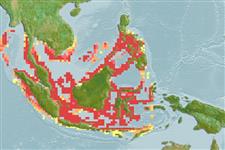>
Syngnathiformes (Pipefishes and seahorses) >
Syngnathidae (Pipefishes and seahorses) > Syngnathinae
Etymology: Hippocampus: Greek, ippos = horse + Greek,kampe = curvature (Ref. 45335).
Environment: milieu / climate zone / profondeur / distribution range
Écologie
marin récifal; non migrateur; profondeur 0 - 32 m (Ref. 128812). Tropical; 15°N - 10°S, 91°E - 128°E
Indo-West Pacific: India (Andaman Islands), Indonesia, Malaysia, Philippines, Singapore, Thailand, Viet Nam. Confused with Hippocampus kuda.
Length at first maturity / Taille / Poids / Âge
Maturité: Lm 8.1 range ? - ? cm
Max length : 18.7 cm OT mâle / non sexé; (Ref. 52034)
Description synthétique
Clés d'identification | Morphologie | Morphométrie
Épines dorsales (Total) : 0; Rayons mous dorsaux (Total) : 17 - 19.
Body shape (shape guide): other.
Length type refers to Height (= from top of coronet to the tip of straightened tail). This species is mainly found in pairs (Ref. 48635) on coral reefs, sponge gardens, kelp, and floating Sargassum. Nocturnal, site faithful. Feeds on zooplankton (Ref. 85309). Ovoviviparous (Ref. 205). The male carries the eggs in a brood pouch which is found under the tail (Ref. 205). Life span probably more than 2-3 years. Used for traditional Chinese medicine (Ref. 85309).
Monogamous mating is observed as both obligate and genetic (Ref. 52884). Male carries the eggs in a brood pouch (Ref. 205). Gestation period 2-3 weeks (but varies with water temperature) (Ref. 30915).
Lourie, S.A., R.A. Pollom and S.J. Foster, 2016. A global revision of the seahorses Hippocampus Rafinesque 1810 (Actinopterygii: Syngnathiformes): taxonomy and biogeography with recommendations for further research. Zootaxa 4146(1):1-66. (Ref. 115213)
Statut dans la liste rouge de l'IUCN (Ref. 130435: Version 2024-2)
Menace pour l'homme
Harmless
Utilisations par l'homme
Pêcheries: commercial; Aquarium: Commercial
Outils
Articles particuliers
Télécharger en XML
Sources Internet
Estimates based on models
Preferred temperature (Réf.
123201): 28.3 - 29.3, mean 28.8 °C (based on 688 cells).
Phylogenetic diversity index (Réf.
82804): PD
50 = 0.5000 [Uniqueness, from 0.5 = low to 2.0 = high].
Bayesian length-weight: a=0.00447 (0.00175 - 0.01142), b=2.99 (2.77 - 3.21), in cm total length, based on LWR estimates for this (Sub)family-body shape (Ref.
93245).
Niveau trophique (Réf.
69278): 3.4 ±0.5 se; based on size and trophs of closest relatives
Generation time: 0.6 ( na - na) years. Estimated as median ln(3)/K based on 1
growth studies.
Résilience (Réf.
120179): Haut, temps minimum de doublement de population inférieur à 15 mois (tm=0.5-1).
Fishing Vulnerability (Ref.
59153): Low vulnerability (10 of 100).
🛈
Nutrients (Ref.
124155): Calcium = 132 [74, 265] mg/100g; Iron = 1.23 [0.66, 2.10] mg/100g; Protein = 17.8 [16.6, 19.1] %; Omega3 = 0.108 [0.056, 0.209] g/100g; Selenium = 45.1 [22.5, 107.3] μg/100g; VitaminA = 65.9 [22.0, 204.1] μg/100g; Zinc = 1.78 [1.15, 2.64] mg/100g (wet weight);
